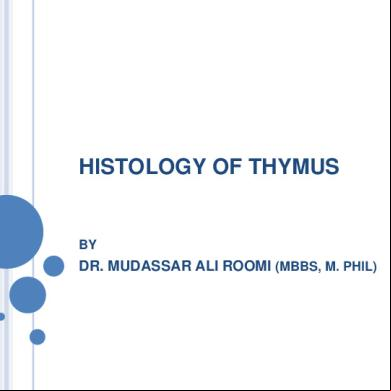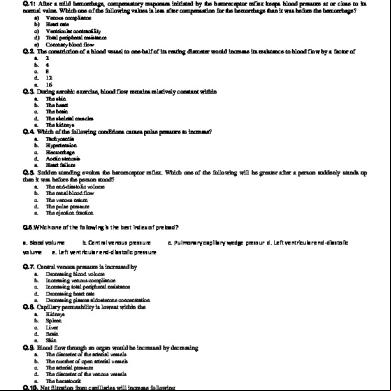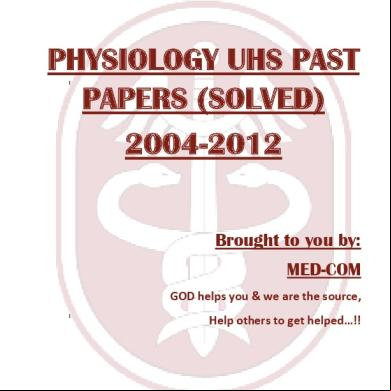Histology Of Thymus By Dr. Roomi 644d47
This document was ed by and they confirmed that they have the permission to share it. If you are author or own the copyright of this book, please report to us by using this report form. Report 3i3n4
Overview 26281t
& View Histology Of Thymus By Dr. Roomi as PDF for free.
More details 6y5l6z
- Words: 900
- Pages: 21
HISTOLOGY OF THYMUS
BY
DR. MUDASSAR ALI ROOMI (MBBS, M. PHIL)
May 2, 2012
THYMUS-INTRODUCTION A bilobed organ Location: Anterior superior Mediastinum Unlike the liver, kidney and heart, the thymus is at its largest in children. Like bone marrow and B cells, the thymus is considered a central or primary lymphoid organ because T lymphocytes form there 2
Whereas all other lymphoid organs originate exclusively from mesenchyme (mesoderm), the thymus has a dual embryonic origin. Its precursor lymphoblasts originate in the bone marrow (mesodermal origin), but then move to invade a unique epithelium that developed from the endoderm of the embryo's third and fourth pharyngeal pouches. So thymus is a lymphoepithelial organ.
May 2, 2012
DEVELOPMENT OF THYMUS
3
The thymus has a connective tissue capsule that penetrates the parenchyma and divides it into incomplete lobules, with continuity between the cortex and medulla of ading lobules . Each lobule has a peripheral darkly stained zone known as the cortex and a central light zone called the medulla. The cortex is richer in small lymphocytes than the medulla and therefore it stains more darkly. Medulla is rich in epithelial cells
May 2, 2012
HISTOLOGY OF THYMUS
4
HISTOLOGY OF THYMUS May 2, 2012
5
1. 2. 3. 4. 5. 6.
May 2, 2012
CELLS OF THYMUS Epithelial cells*** Lymphocytes*** Macrophages Plasma cells Mast cells adipocytes
6
1:EPITHELIAL CELLS
Six forms of these cells Type II cells: these cells appear as stellate cells with slender processes. These cells form cytoreticulum in which T-cells are tightly packed. Processes of these cells are ed together by desmosomes. No fibers are associated with these epithelioreticular cells Type I cells: these epithelial cells form the blood-thymus barrier. Type VI cells: these epithelial cells form the thymic corpuscles (Hassal’s corpuscles)
May 2, 2012
7
HASSAL’S CORPUSCLES (*****)
May 2, 2012
Rounded or oval whorl-like structures 20-100 um in diameter Found in the medullary regions of the thymic lobules Each consists of concentrically arranged flat, eosinophilic epithelial cells These cells contain keratin filaments Central cells lose their nucleus and make keratinized aggregations. 8
EPITHELIAL CELLS OF THYMUS
May 2, 2012
9
2: T-LYMPHOCYTES 95 % of T-lymphocytes are in the cortex and 5 % in the medulla.
10 % of the total thymic lymphocytes are present in the peripheral cortex. these represent large lymphocytes (stem cells). These proliferate very actively and produce small lymphocytes.
Deeper cortex contains small lymphocytes (thymocytes). These are maturing cells and constitute 85 % of the total thymic lymphocytes.
Most of the T-cells (which don’t show immune tolerance) die in the cortex and are phagocytosed by macrphages.
May 2, 2012
10
May 2, 2012
THYMUS
11
May 2, 2012
THYMUS
12
HOW TO DRAW IT? May 2, 2012
13
BLOOD-THYMUS BARRIER It exits in the cortex only making it an immunologically protected region
Macromolecules cannot from the capillaries to the thymic parenchyma in the cortical region of thymic lobules.
It protect the cortical lymphocytes from the circulating antigens
Structural basis of blood-thymus barrier:
1.
Tight junctions between the endothelial cells of the capillaries.
2.
Basal lamina of endothelial cells.
3.
C.T with macrophages.
4.
basal lamina of thymic epithelial cells.
5.
Perivascular sheath of thymic epithelial cells.
May 2, 2012
14
INVOLUTION OF THYMUS
WEIGHT OF THYMUS AT DIFFERENT AGES:
May 2, 2012
TYPES OF INVOLUTION: 1. Age involution: 2. Accidental involution: The thymus continues to grow between birth and puberty and then begins to atrophy; this thymic involution is directed by the high levels of circulating hormones. Proportional to thymic size, thymic activity (T-cell output) is most active before puberty. Upon atrophy, the size and activity are dramatically reduced, and the organ is primarily replaced with fat (a phenomenon known as "organ involution"). The atrophy is due to the increased circulating level of sex hormones, and chemical or physical castration of an adult results in the thymus increasing in size and activity. Involution of the thymus has been linked to loss of immune function in the elderly, susceptibility to infection and to cancer.
15
COMPARISON
OF NORMAL AND INVOLUTED THYMUS May 2, 2012
16
FUNCTIONS OF THYMUS May 2, 2012
Production of Tlymphocytes: after their production T-cells are carried by blood to their thymusdependent zones in the spleen, lymph nodes and other lymphoid organs. Production of hormones by epithelial cells
17
HORMONES ACTING ON THE THYMUS
2. 3.
4. 5.
Thymosin: tranforms stem lymphocytes to Tlymphocytes. Thymopoitin: induces T-cells maturation Thymic humoral factor: essential for T-cells diffentiation. Thyroxine Adrenal steroids: depress the T-cells formation in the thymus.
May 2, 2012
1.
18
CLINICAL IMPORTANCE OF THYMUS May 2, 2012
Accelerated involution (by stress, steroids and infection) Neonatal thymectomy: severely impairs the cell mediated and humoral immunity. Adult thymectomy: causes less severe impairment of the immunity Congenital thymic aplasia (DiGeorge Syndrome): absence of thymus and parathyroid glands. Leads to hypocalcemia and recurrent infections. AIDS: destruction of CD4+ helper T-cells. Autoimmune diseases: because of failure of immune tolerance. e.g. myasthenia gravis.
19
IDENTIFICATION POINTS: THYMUS May 2, 2012
Characteristic lobules with cortex and medulla Hassall’s corpuscles No lymph sinuses No lymphatic nodules
20
May 2, 2012
COMPARISON
21
BY
DR. MUDASSAR ALI ROOMI (MBBS, M. PHIL)
May 2, 2012
THYMUS-INTRODUCTION A bilobed organ Location: Anterior superior Mediastinum Unlike the liver, kidney and heart, the thymus is at its largest in children. Like bone marrow and B cells, the thymus is considered a central or primary lymphoid organ because T lymphocytes form there 2
Whereas all other lymphoid organs originate exclusively from mesenchyme (mesoderm), the thymus has a dual embryonic origin. Its precursor lymphoblasts originate in the bone marrow (mesodermal origin), but then move to invade a unique epithelium that developed from the endoderm of the embryo's third and fourth pharyngeal pouches. So thymus is a lymphoepithelial organ.
May 2, 2012
DEVELOPMENT OF THYMUS
3
The thymus has a connective tissue capsule that penetrates the parenchyma and divides it into incomplete lobules, with continuity between the cortex and medulla of ading lobules . Each lobule has a peripheral darkly stained zone known as the cortex and a central light zone called the medulla. The cortex is richer in small lymphocytes than the medulla and therefore it stains more darkly. Medulla is rich in epithelial cells
May 2, 2012
HISTOLOGY OF THYMUS
4
HISTOLOGY OF THYMUS May 2, 2012
5
1. 2. 3. 4. 5. 6.
May 2, 2012
CELLS OF THYMUS Epithelial cells*** Lymphocytes*** Macrophages Plasma cells Mast cells adipocytes
6
1:EPITHELIAL CELLS
Six forms of these cells Type II cells: these cells appear as stellate cells with slender processes. These cells form cytoreticulum in which T-cells are tightly packed. Processes of these cells are ed together by desmosomes. No fibers are associated with these epithelioreticular cells Type I cells: these epithelial cells form the blood-thymus barrier. Type VI cells: these epithelial cells form the thymic corpuscles (Hassal’s corpuscles)
May 2, 2012
7
HASSAL’S CORPUSCLES (*****)
May 2, 2012
Rounded or oval whorl-like structures 20-100 um in diameter Found in the medullary regions of the thymic lobules Each consists of concentrically arranged flat, eosinophilic epithelial cells These cells contain keratin filaments Central cells lose their nucleus and make keratinized aggregations. 8
EPITHELIAL CELLS OF THYMUS
May 2, 2012
9
2: T-LYMPHOCYTES 95 % of T-lymphocytes are in the cortex and 5 % in the medulla.
10 % of the total thymic lymphocytes are present in the peripheral cortex. these represent large lymphocytes (stem cells). These proliferate very actively and produce small lymphocytes.
Deeper cortex contains small lymphocytes (thymocytes). These are maturing cells and constitute 85 % of the total thymic lymphocytes.
Most of the T-cells (which don’t show immune tolerance) die in the cortex and are phagocytosed by macrphages.
May 2, 2012
10
May 2, 2012
THYMUS
11
May 2, 2012
THYMUS
12
HOW TO DRAW IT? May 2, 2012
13
BLOOD-THYMUS BARRIER It exits in the cortex only making it an immunologically protected region
Macromolecules cannot from the capillaries to the thymic parenchyma in the cortical region of thymic lobules.
It protect the cortical lymphocytes from the circulating antigens
Structural basis of blood-thymus barrier:
1.
Tight junctions between the endothelial cells of the capillaries.
2.
Basal lamina of endothelial cells.
3.
C.T with macrophages.
4.
basal lamina of thymic epithelial cells.
5.
Perivascular sheath of thymic epithelial cells.
May 2, 2012
14
INVOLUTION OF THYMUS
WEIGHT OF THYMUS AT DIFFERENT AGES:
May 2, 2012
TYPES OF INVOLUTION: 1. Age involution: 2. Accidental involution: The thymus continues to grow between birth and puberty and then begins to atrophy; this thymic involution is directed by the high levels of circulating hormones. Proportional to thymic size, thymic activity (T-cell output) is most active before puberty. Upon atrophy, the size and activity are dramatically reduced, and the organ is primarily replaced with fat (a phenomenon known as "organ involution"). The atrophy is due to the increased circulating level of sex hormones, and chemical or physical castration of an adult results in the thymus increasing in size and activity. Involution of the thymus has been linked to loss of immune function in the elderly, susceptibility to infection and to cancer.
15
COMPARISON
OF NORMAL AND INVOLUTED THYMUS May 2, 2012
16
FUNCTIONS OF THYMUS May 2, 2012
Production of Tlymphocytes: after their production T-cells are carried by blood to their thymusdependent zones in the spleen, lymph nodes and other lymphoid organs. Production of hormones by epithelial cells
17
HORMONES ACTING ON THE THYMUS
2. 3.
4. 5.
Thymosin: tranforms stem lymphocytes to Tlymphocytes. Thymopoitin: induces T-cells maturation Thymic humoral factor: essential for T-cells diffentiation. Thyroxine Adrenal steroids: depress the T-cells formation in the thymus.
May 2, 2012
1.
18
CLINICAL IMPORTANCE OF THYMUS May 2, 2012
Accelerated involution (by stress, steroids and infection) Neonatal thymectomy: severely impairs the cell mediated and humoral immunity. Adult thymectomy: causes less severe impairment of the immunity Congenital thymic aplasia (DiGeorge Syndrome): absence of thymus and parathyroid glands. Leads to hypocalcemia and recurrent infections. AIDS: destruction of CD4+ helper T-cells. Autoimmune diseases: because of failure of immune tolerance. e.g. myasthenia gravis.
19
IDENTIFICATION POINTS: THYMUS May 2, 2012
Characteristic lobules with cortex and medulla Hassall’s corpuscles No lymph sinuses No lymphatic nodules
20
May 2, 2012
COMPARISON
21









